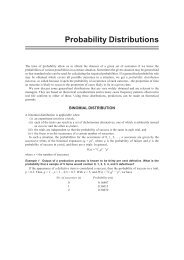International-Business-Dr-R-Chandran-E-book
International-Business-Dr-R-Chandran-E-book
International-Business-Dr-R-Chandran-E-book
You also want an ePaper? Increase the reach of your titles
YUMPU automatically turns print PDFs into web optimized ePapers that Google loves.
218<br />
<strong>International</strong> <strong>Business</strong>- <strong>Dr</strong>. R. <strong>Chandran</strong><br />
The major cost relationships are discussed, starting with storage and<br />
warehousing. The major cost breakdown is outlined below, with the<br />
percentage values indicating the approximate relative importance of the<br />
different factors based on conventional warehouses.<br />
Percentage<br />
I. Building costs including rent, furnishing and depreciation 24<br />
II. Building services, such as heating and lighting 16<br />
III. Equipment related 13<br />
IV. Labour overheads 38<br />
V. Management, supervision and security 9<br />
Procurement<br />
Procurement is one of the key links in the supply chain. It can have a<br />
significant influence on the overall success of the organisation. Ensuring that<br />
there is a sufficient supply of raw materials of the required quality, at the<br />
right price, in the right place at a right time is obviously crucial to any<br />
manufacturing plant. Over the years many organizations have developed<br />
large departments to deal with the sheer weight of supplier transactions.<br />
Recently, many companies have reduced the number of suppliers in order t<br />
reduce the cost of transactions. Single entity takes the responsibility and<br />
committed to supply many product lines required by customers.<br />
In addition to supplier reduction programmes many companies have moved<br />
away from the traditional adverse relationship with suppliers. Companies<br />
practice cooperation and coexistence concept wherein the buyer is also part<br />
of supplier. This style of relationship recognizes that both the parties need to<br />
make a profit to survive.<br />
Procurement is not just about raw materials. The following goods and<br />
services also need to be acquired:<br />
1. Utilities like gas, water, electricity and telephones<br />
2. Fuel including diesel and petrol<br />
3. Capital assets such as machinery, vehicles and buildings<br />
4. Stationery<br />
5. Consultancy services<br />
6. Outsourced services such as distribution contracts, IT services etc.<br />
7. IT equipment, e.g., hardware, software and support systems.<br />
Very large sums of money are involved in the above areas. Depending on<br />
the nature of business of the organization concerned, emphasis will be<br />
Only for Private Circulation





